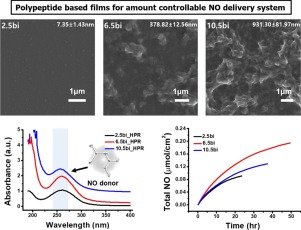当前位置:
X-MOL 学术
›
J. Ind. Eng. Chem.
›
论文详情
Our official English website, www.x-mol.net, welcomes your
feedback! (Note: you will need to create a separate account there.)
Poly-L-lysine/poly-L-glutamic acid-based layer-by-layer self-assembled multilayer film for nitric oxide gas delivery
Journal of Industrial and Engineering Chemistry ( IF 5.9 ) Pub Date : 2019-01-01 , DOI: 10.1016/j.jiec.2018.09.005 Kyungtae Park , Hyejoong Jeong , Junjira Tanum , Jae-Chan Yoo , Jinkee Hong
Journal of Industrial and Engineering Chemistry ( IF 5.9 ) Pub Date : 2019-01-01 , DOI: 10.1016/j.jiec.2018.09.005 Kyungtae Park , Hyejoong Jeong , Junjira Tanum , Jae-Chan Yoo , Jinkee Hong

|
Abstract Nitric oxide (NO) gas is an endogenously produced radical gas involved in numerous physiological and pathological processes in the human body and shows potential for biomedical applications. Numerous studies have attempted to develop an NO-releasing platform in the past few decades. To take advantage of exogenous NO gas delivery, controlling the total concentration and release profile are the most important factors. To develop a controlled NO-releasing system, we used the poly- l -lysine (PLL) and poly- l -glutamic acid (PGA) because of their high biocompatibility in biomedical applications. We constructed (PLL/PGA)n multilayer thin films using the layer-by-layer self-assembly technique. We then synthesized the N-diazeniumdiolate, a proton-responsive NO donor, into the polypeptide multilayer film in a high-pressure reaction under NO gas. We investigated the film growth profile by quartz crystal microbalance and thickness measurements and determined the film surface morphology by scanning electron microscopy and atomic force microscopy. By comparing films with different thicknesses, we confirmed NO donor formation by UV–vis and Fourier-transform infrared spectroscopy. We also determined the release profiles of each film using a real-time NO analysis machine (NOA280i).
中文翻译:

用于一氧化氮气体输送的基于聚-L-赖氨酸/聚-L-谷氨酸的逐层自组装多层膜
摘要 一氧化氮 (NO) 是一种内源性自由基气体,参与人体多种生理和病理过程,具有生物医学应用潜力。在过去的几十年中,许多研究试图开发 NO 释放平台。为了利用外源性 NO 气体输送,控制总浓度和释放曲线是最重要的因素。为了开发受控的 NO 释放系统,我们使用了聚-l-赖氨酸(PLL)和聚-l-谷氨酸(PGA),因为它们在生物医学应用中具有高生物相容性。我们使用逐层自组装技术构建了 (PLL/PGA)n 多层薄膜。然后,我们在 NO 气体下通过高压反应将质子响应性 NO 供体 N-diazeniumdiolate 合成到多肽多层膜中。我们通过石英晶体微量天平和厚度测量研究了薄膜生长曲线,并通过扫描电子显微镜和原子力显微镜确定了薄膜表面形态。通过比较不同厚度的薄膜,我们通过紫外-可见光和傅里叶变换红外光谱证实了 NO 供体的形成。我们还使用实时 NO 分析机 (NOA280i) 确定了每张薄膜的释放曲线。
更新日期:2019-01-01
中文翻译:

用于一氧化氮气体输送的基于聚-L-赖氨酸/聚-L-谷氨酸的逐层自组装多层膜
摘要 一氧化氮 (NO) 是一种内源性自由基气体,参与人体多种生理和病理过程,具有生物医学应用潜力。在过去的几十年中,许多研究试图开发 NO 释放平台。为了利用外源性 NO 气体输送,控制总浓度和释放曲线是最重要的因素。为了开发受控的 NO 释放系统,我们使用了聚-l-赖氨酸(PLL)和聚-l-谷氨酸(PGA),因为它们在生物医学应用中具有高生物相容性。我们使用逐层自组装技术构建了 (PLL/PGA)n 多层薄膜。然后,我们在 NO 气体下通过高压反应将质子响应性 NO 供体 N-diazeniumdiolate 合成到多肽多层膜中。我们通过石英晶体微量天平和厚度测量研究了薄膜生长曲线,并通过扫描电子显微镜和原子力显微镜确定了薄膜表面形态。通过比较不同厚度的薄膜,我们通过紫外-可见光和傅里叶变换红外光谱证实了 NO 供体的形成。我们还使用实时 NO 分析机 (NOA280i) 确定了每张薄膜的释放曲线。









































 京公网安备 11010802027423号
京公网安备 11010802027423号